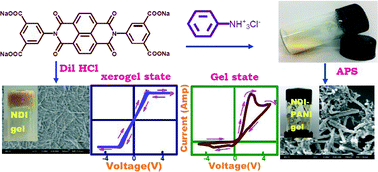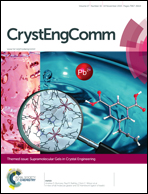Conducting hydrogel of a naphthalenetetracarboxylic dianhydride derivative and polyaniline: different electronic properties in gel and xerogel states†
Abstract
An aminoisophthalic acid derivative of naphthalenetetracarboxylic dianhydride (NDI) is synthesized to produce a hydrogel via acid–base treatment. NDI is used to make co-assembled hydrogels with polyaniline (PANI) by in situ polymerization of aniline, and these are named NP0.5, NP1.0 and NP1.5 according to the amount (ml) of anilinium chloride solution. The NDI gel exhibits a fibrillar network morphology, and in the NDI-PANI gels a change in fiber texture occurs. The FTIR and NMR spectra indicate the presence of supramolecular interactions in the NDI-PANI gels and the PANI produced in the gel is in the emeraldine salt (ES) form which is also supported by UV-vis spectroscopy results. X-ray diffraction indicates the NDI gel has a lamellar structure and the lamellar distance increases significantly in the NDI-PANI gels. A schematic model of the supramolecularly organized structure with alternating NDI and PANI chains is proposed for fiber formation. Rheological study indicates storage (G′) and loss (G′′) moduli to be invariant with frequency and a 213- and 112-time increase in G′ and G′′ is observed for the NP1.5 gel. Also, it's elasticity increases by 22 463%, yield stress by 905% and stiffness by 88%, as compared to those of the NDI gel. The NP1 xerogel exhibits the highest dc conductivity (5.2 × 10−3 S cm−1) and the current (I)–voltage (V) curves of the xerogels are different from those of the gels; the former exhibits the characteristics of a semiconductor–metal junction and the latter exhibits negative differential resistance with rectification properties, simultaneously. The Nyquist plots of the impedance values also indicate a difference between the xerogel and gel state; in the former only semicircles are observed, but in the latter a semicircle and a sloping line are noticed. The difference in the I–V properties in the xerogel and gel state is attributed to the diffusion controlled movement of the charge carriers through the water molecules in the gels and it is supported by the sloping line in the Nyquist plot of the gels.

- This article is part of the themed collection: Supramolecular Gels in Crystal Engineering

 Please wait while we load your content...
Please wait while we load your content...